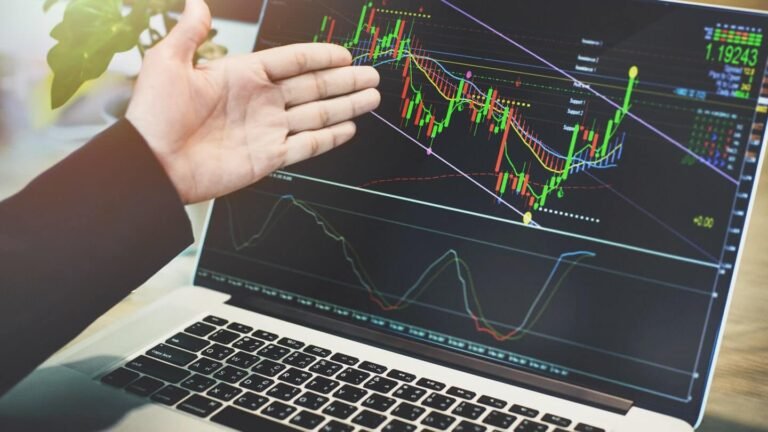Forget crystal balls, trade like a pro with forex indicators!
Ever wished you could see what the future holds for the currency market? Imagine knowing exactly when to buy, sell, and skyrocket your profits while leaving losses in the dust.
Hold on, because this isn’t some magic trick! It’s the power of technical indicators, simple tools hiding right on your trading PC platform or smartphone.
Sound too good to be true? It’s not!
These indicators are like secret weapons used by pros to unlock trends, pinpoint juicy opportunities, and avoid nasty pitfalls.
But how do you wield these indicators like a trading Jedi? This guide will be your map to forex mastery! We’ll show you how to pick the perfect indicators for your trading style, unleash their power, and become a confident currency conqueror.
Get ready to ditch the guesswork and trade like a pro cfd broker.
Understanding Technical Indicators
Forex indicators are basically fancy math equations that crunch price and volume data, spitting out visual clues and chart patterns to guide your trades. Think of them as tiny market detectives, sniffing out trends and potential trouble zones.
But remember, these indicators ignore outside gossip like news and economics. They only focus on pure market action.
Technical indicators can be classified into two main types: trend indicators and oscillators.
- Trend indicators help traders identify the direction and strength of the market trend and spot trend reversals. They are usually plotted on the same chart as the price, and they move along with it. Trend indicators include moving averages, trend lines, and Ichimoku Cloud.
- Oscillators measure the momentum and volatility of the market and identify overbought and oversold conditions. Traders plot them on a separate window below the price chart, and they move within a fixed range, such as 0 to 100. Some examples of oscillators are relative strength index (RSI), moving average convergence divergence (MACD), and stochastic.
How to Implement Technical Indicators in Forex Trading
Now that you have a basic understanding of technical indicators, let’s see how you can implement them in your forex trading. Here are some steps you can follow to use technical indicators effectively.
Set up Charts and Select Timeframes
The first step is to set up your charts and select the appropriate timeframes for your trading. You can use any charting software or platform that supports technical indicators. You can customize your charts with different colors, styles, and layouts.
After setting up charts, select the timeframes that match your trading style and goals. You can employ different timeframes to analyze the market from different perspectives and identify trends.
Combine Multiple Indicators For Confirmation
Select different indicators to complement each other and provide more information and insight about the market. You can use moving averages to determine the trend direction and relative strength index (RSI) to measure the volatility.
However, you should not use too many or conflicting indicators, which can lead to confusion and paralysis.
Also, only select the indicators that provide clear signals and patterns.
Backtest Strategies Using Historical Data
Backtesting is applying your trading rules and indicators to past market data and evaluating the results and performance.
Backtesting can help you verify the validity of your indicators so you know their strengths and weaknesses. It can also help you to fine-tune your trading parameters to avoid overfitting and curve-fitting.
However, you should not rely solely on backtesting, as it is based on historical data, which may not reflect current and future market situations.
Set Entry and Exit Points
Technical indicators are also helpful in generating buy and sell signals and determining the optimal levels to enter and exit the market.
For example, you can use a crossover of two moving averages to indicate a trend reversal or a divergence of MACD and price to signal a momentum shift.
However, you should not blindly follow the signals and patterns from your indicators, as they may not always be accurate or timely. That’s why you should use your analysis and consider market conditions like trend direction, price action, and the news.
Tips and Best Practices for Using Technical Indicators
Many traders make certain mistakes when using technical indicators. We have listed some tips and best practices below to avoid these common pitfalls.
- Do not rely solely on technical indicators; use them to complement other analysis methods.
- Avoid using too many or conflicting indicators, as this can lead to confusion and paralysis.
- Confirm and validate the signals and patterns from different indicators.
- Backtest and forward-test your strategies using historical and live data, and evaluate the results and performance.
- Manage your risk and protect your capital. Set a stop-loss and a take-profit level for each trade based on your indicators and trading plan.
Conclusion
Technical indicators are one of the most essential and widely used tools in forex trading. They help traders analyze the market and make informed decisions.
However, technical indicators are not perfect. They have some drawbacks, such as lagging and being prone to false signals. Therefore, you should not rely solely on them but use them as a part of a balanced and comprehensive approach to forex trading.
Read More: Cryptocurrency and Betting: Navigating the Future

